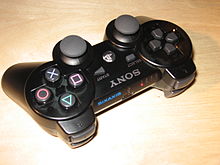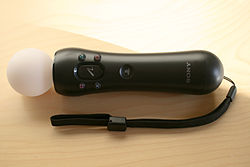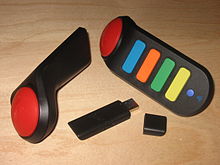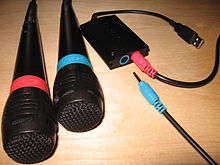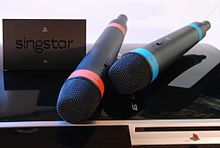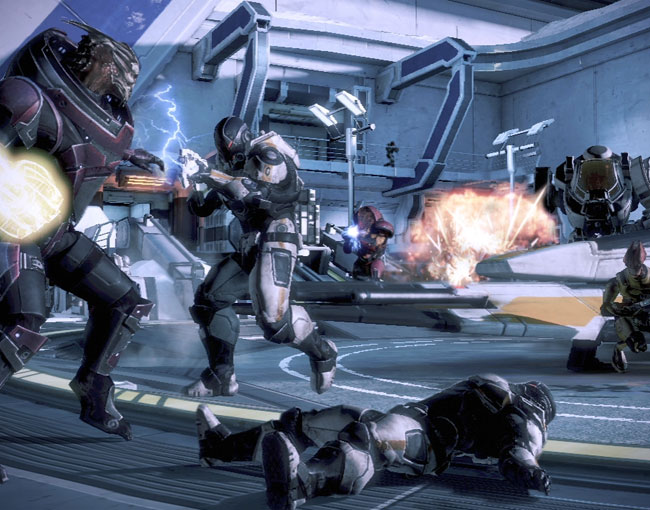 The PlayStation 3 (Sony until August 2009 PlayStation 3 written; Japan: produced, Hepburn romanization: PlayStation marketed, often abbreviated as: PS3) is a video game console by Sony computer entertainment. She was introduced in May 2005 at E3 in Los Angeles, California as the official successor to the PlayStation2. Start of sales of the PlayStation 3 was in Japan on November 11, 2006, in North America on November 17, 2006 and in Europe on March 23, 2007. As the so-called "7th generation" console, it competes with the Wii by Nintendo and the Xbox 360 from Microsoft. By March 29, 2011, 50 million copies of the PS3 have been delivered worldwide. In addition to its function as a video game platform is the PS3 able to play audio CDs, DVDs and Blu-ray discs. More music, picture and video files of different formats can be reproduced from the internal hard drive, an external medium or via a DLNA-compliant media server on the network connections and copied. The console Various versions of the PlayStation 3 have been published since the 2006 launch. The current version is the PlayStation 3 slim. It is above all by a smaller housing from the older versions which are no longer manufactured. For all the differences, see model overview The PlayStation 3 slim costs since their launch in September 2009 officially 299 € (299.99 was$, 29.980 ¥). She will be delivered with a Dualshock 3 controller and a 120 GB hard drive. The hard drive can be exchanged for a standard 2, 5-inch S-ATA drive; a special Sony product is not necessary. The signal of the PlayStation can be issued digitally via HDMI (version 1.3). Analog console emits the signal than composite video, S-video or component video, partly a supplied adapter is required for this purpose. The sound is issued either via HDMI or optical digital output. The console can play also some content (via HDMI) in stereoscopic 3D version 3.50 from firmware. These include 3D games and some movies on Blu-ray disc. However, for a 3D-Wiedergabe, a 3D-fähiges TV set is necessary. The console has a system software, which can be extended by new features through updates. Sony provides these updates that fix also known bugs from time to time available. The version 4.11. is currently (since February 16, 2012) History of the hardware versions Rear view with connectors from left to right: HDMI, Gigabit-LAN, optical audio output, AV, 220 V with main switch The two first models of the PlayStation 3 came almost simultaneously in Japan and the United States out; a 60 GB version and a slimmed-down with 20 GB. In Japan the 20 GB model was not, as announced, to 59,800 yen (around 375 € or CHF 610) on the market, but for only 49.980 yen (around 315 € or CHF 510). The 20 GB version of the console does not have connectors for memory stick duo, SD and Compact Flash cards and no IEEE 802.11 b/g (WLAN) interface. But, missing functions can be retrofitted with equipment on the USB ports. The PS3 should be originally generally backward-compatible with all PlayStation 2 and PlayStation games, which was also ensured by the first versions in Japan and the United States. The first version available in Europe showed already a hardware change: the backward compatibility was now ensured by a combination of hardware and software. Were in the first version of the PlayStation 3 have both devices (EmotionEngine and graphics synthesizer) PlayStation 2 used, now he was used "Graphics Synthesizer". This initially however, many older games did not work or only limited. If a certain game titles with the console is compatible, is to look up only in an unofficial compatibility list after the official list of Sony previously provided is no longer available on the On July 9, 2007, Sony announced from immediately the price in the United States of 599 499 was $ to reduce and to offer a new version with 80 GB hard drive, which together with the game MotorStorm for 599 US$ was sold. At the same time were the remainders of the 60 GB version sold there. The second version for Europe had a 40 GB hard drive and now completely renounced the backward compatibility. According to Sony wanted it so only secondary save production costs, but primarily encourage customers to purchase new PlayStation 3-software titles. In addition, this version had only two USB ports (instead of originally four) and more contained no card reader. The retail price was CHF 399 €/ 649. This version was announced by Sony on October 5, 2007 and was available from October 10, 2007, exclusively in Europe. The current 60 GB model, which most recently was sold as starter pack with two games and a second controller, cost only 499 € as of 12 October and was no longer offered after the sale of the devices produced until then. The third version for Europe was released in August 2008. However, these had a 80 GB hard drive in contrast to the second Euro-version. Otherwise, it was identical with the 40 GB model. The 40 GB model was no longer produced. With the release of PAL-80 GB model is the console also instead of Sixaxis-a Dualshock 3 controller in. The price remained stable at 399 €. At the Games Convention 2008, a fourth version for Europe was announced by Sony which end of October 2008 was released. This was identical to the previous versions up to a still larger hard drive of 160 GB and was limited to the holiday shopping season. In addition, a gift certificate was at in this case over 70 € for download content from the PlayStation Store. In August 2009, a scaled down version (slim) the PS3 was announced by Sony on the gamescom. It was released on September 1, 2009, for 299 € and is 32% smaller, 36% lighter and needs 34% less power. Also used a new 45 nm version of cell, which has a lower power consumption. It was confirmed now from different sources, that the installation of games to the hard drive on the PS3 slim takes not so much time like in the conventional PS3. However, some games on the PS3 slim should have longer loading times than the original model. Still was the HDMI interface of the console to DTS-HD MA and Dolby TrueHD audio Bitstreaming expanded. But at the same time a new HDMI controller chip of the brand Panasonic was a light noise of the HDMI signal of the console. On 6 July, Sony announced the release of a further revision of the console. This is different to the previous model in the size of the hard drive which is great either 160 GB or 320 GB. The 160 GB model will be published also in white. On August 17, 2010 Sony gamescom press conference in part, announced that both the 160-GB and the 320 GB model in Europe will be published but only in black. Removal of support for other operating systems Since the slim version, it is no longer possible to install Linux or other operating systems on the PS3. Also owner of previous hardware versions can no longer use this feature after upgrading to firmware version 3.21. Users who deny the firmware update, exposed significant functional limitations: you can install, for example, no new games or play online. In the United States several legal proceedings against Sony are pending, because this process because the company here beyond a feature customers after the purchase of the product. Marketing and sales On July 13, 2007, Sony Computer Entertainment Europe (SCEE) communicated that you would not lower the selling price for the PS3 in Europe. It will offer but a "Starter Pack" from the beginning of August, which will contain two controllers and two "best seller" games in addition to the console. This corresponds to a value of at least 150 euros. SCEE President David Reeves stated that around 1.2 million PS 3 are been sold until the date of the communication in Europe, although only a version on the market is. According to media reports in August 2007, 1.08 million consoles were sold up in Japan, in the United States it was about 1.78 million and in Europe 1.25 million. The worldwide market share was specified in these reports with 16.7 percent. Jack pedal tone, President of Sony Computer Entertainment America, forecast 3 to end of March 2008, in July with a worldwide sales of approximately 11 million PS what would correspond to the original design. The new model and pricing in the United States will help to achieve this goal. An increase in the number of sales has been registered since the introduction of the cheaper 40 GB version. Until early 2008 a total of approximately 3.87 million, in Japan over 1.93 million and the rest of the world market as were sold in America 4.24 million copies. Thus, the total number was around the world in February 2008 at least 10.03 million. End of January 2009 this number had increased to over 20 million, of which approximately 8.1 million copies in Europe, 7.75 million in America and 2.8 million in Japan. Sales in Germany according to the GfK 2007: 387.000 2008: 501.000 2009: 677.000 2010: 661.000 Official accessories
SIXAXIS controller The SIXAXIS controller for the PlayStation 3 optically largely corresponds to the controller of the PS2, but is a new development without the known, switchable "Rüttel" function, with half-transparent housing and without fixed wiring. Later models got a non transparent case back. The connection to the console is now either wirelessly via Bluetooth or a USB cable. The energy for the operation of Bluetooth is taken from an internal battery which can be charged via the USB cable. The L2/R2 shoulder buttons have a much larger movement the shoulder buttons of the Xbox 360 gamepad in contrast to the dual shock, similar to, so that the pressure can be significantly more precisely determined. The remaining buttons and the two analog joysticks are largely unchanged. An essential innovation of the controller, which is also the namesake, is a sensor that registered movements of the controller of all axes and transfers as control data to the console. In addition, the SIXAXIS uses a so-called button of PS, with the system on and off controller reported to renumbered, and called a system menu be can. Up to seven such controllers can be registered for a console. Here, the four LEDs indicate the controller number and the respective status. Now, Sony has discontinued the production of the SIXAXIS. Because of this, there are now only has the dual shock 3, which thus becomes the default controller for the PS3. Dualshock 3 Sony introduced 2 controller the successor of dual shock in November 2007 in Japan, again has in contrast to the SIXAXIS a vibration feature. The Dualshock 3 in Europe is available since July 2008. Since the controller supports also the SIXAXIS functions of its predecessor, the Dualshock 3 and SIXAXIS logo is on the controller. The Rüttel effect is the dual shock 2 in strength, because the same engines used. The battery life is reduced depending on the use of the vibration function, is still approximately 27 to 31 hours. To the launch of the dual shock 3 offered already some games (such as ratchet & Clank Future: tools of destruction or Burnout: Paradise) support for the vibration function, partly they even in the context of a software update presented to (such as MotorStorm). Support the Dualshock 3 requires the firmware version 1.94 (or later).
PlayStation move PlayStation move controller On September 15, 2010, is a motion-sensitive controller PlayStation move added, which offers a similar functionality as the controller of the Wii. On April 15, 2011, Sony announced that 8.0 million units of the motion-sensitive controller have been sold since the release of move. Bluetooth remote control (BD remote) Bluetooth remote control As already for the PlayStation 2, there is a remote control of the system (primarily video playback). It is connected via Bluetooth to the system, while its predecessor was the PlayStation 2 via infrared. It has all the common functions for playback of DVDs and Blu-ray discs, controls but also how of all other formats such as photo albums, and MP3s. It also contains all the buttons of the SIXAXIS controller, making it possible to play to the limited extent through the remote control except for the two Analogsticks and the tilt sensors. When it is used, the number of registerable controller to six are reduced because the remote control as "Controller 7" is logged in. PlayStation Eye PlayStation Eye As the successor of the popular EyeToy camera, Sony has the PlayStation Eye is presented. This is a camera with a resolution of 640 × 480 pixels at 60 Hz and 320 × 240 at 120 Hz. opposite its predecessor has the new development of a significantly improved sensitivity and a four-capsule microphone which allows intelligent language from every direction. In addition, a zoom function was added, allows the two zoom settings. On October 24, 2007, the software EyeCreate was made free download available with which images, videos and audio recordings on the hard disk, exported with various effects can be stored and. Is in the future not only in camera-driven games such as EyeToy, but also as add-on for games such as SingStar, such as the camera, PlayStation Home, and video chat with other PlayStation owners. It will be possible in future gaming developments to transfer the face of the player to the character in the game (Tiger Woods PGA Tour 08), by the camera three-dimensional scans the player. To the game "EyePet" was released in September 2009, presenting a virtual animal. This "animal" can one camera "educate, feed and play". Release date of the PlayStation Eye was the 21 November, 2007. Buzz!-wireless buzzer
Wireless buzzer For the quiz game buzz! introduced 2 their own game controllers to Sony for the PlayStation. It was a set of four cable-bound Buzzern, which together are connected to a USB port on the console. The buzzer have a large, round, illuminierbaren buzzer and four coloured answer buttons on the top. You been offered July 2008 by Sony and produced by Namtai wireless buzzers are both the PlayStation 3 and the PlayStation 2 compatible. Also can wired buzzer for the PS3 version of buzz! be used. Be delivered a USB stick with receiver and four wireless buzzer in a storage bag. It is uses the same wireless technology such as wireless keyboards and mice (no Bluetooth). The buzzer are for all of the "buzz!"- and "Buzz!" Junior "series suitable." Up to eight players can take part with two sets. SingStar microphones
Wired SingStar microphones with USB converter As already in SingStar for PS2, optional microphones are supplied also in the PS3 version of the karaoke game. They exist in a wired and a wireless version. The wired microphones is the same as for the PlayStation 2. These are Mono microphones and connected to a supplied USB converter, which is connected to the USB port of the PlayStation. It is possible to operate the microphones on a normal 3, 5 mm stereo Jack easily. The USB converter is connected to a PC - Windows XP and Ubuntu recognized as a microphone and installed automatically, where the two Jack connections each work as a stereo channel. With the two connected SingStar microphones, stereo recordings on the computer are possible.
Wireless SingStar microphones The wireless SingStar microphones announced long in advance in Germany in the trade are available since March 25, 2009. Which microphones at a later date in the bundle with the SingStar Pop edition distributed. A supplied USB converter is still required for the connection. This is - connected how wired microphones - already in to a USB port on the PlayStation. In contrast to the wired version, the connection is made now wirelessly from the converter to the microphones. There is no one way to connect the microphones directly via Bluetooth to the PlayStation 3. Thus, the microphones to the PlayStation 2 backwards compatibility ensures continue. Guitar A wireless controller in the form of a Les Paul guitar was developed for the game Guitar Hero III. There are five colored buttons that must be pressed to the music played in the right combination, while at the same time a back federnder rocker arm - instead of strings - is struck on the fingerboard. PlayTV On September 17, 2008 "PlayTV" in Germany a DVB-T twin tuner, which is connected via USB, introduced. Included is a software that adds a new icon to the PlayStation menu. PlayTV is a dual tuner able to record a TV show on the internal hard drive, while an other TV channel is regarded. In addition, the system has an electronic program guide, with which you can program recordings. Bluetooth headset The Bluetooth headset is compatible with all PlayStation 3 systems and with most Bluetooth enabled mobile phones. The talk time is up to 8 hours, standby time up to 300 hours. The charging time is approximately 3 hours. The function range of the headset is about 10 metres. Bluetooth keyboard A wireless keypad on a controller can be plugged to the easier text input. It has a touchpad mode which turns the main buttons in a kind of mouse. The keypad has Bluetooth ® 2.0 and works up to 10 meters away. Instead but also a keyboard with konventionellerem appearance can be purchased. PlayStation Network The "PlayStation Network" is Sony's free online service for the PlayStation. Any PlayStation 3 users must necessarily create a user on the console menu - much like in PC operating systems. In this, the user on the console menu can an online ID for the PlayStation Network create and link it to the user name on the console (enable). An online ID can be enabled at the same time on five consoles, making it possible to use downloaded and purchased content on multiple consoles at the same time. An online ID can but more than once at the same time in the PlayStation Network to be logged. Multiple users on a console are created, such as for family members or WG inhabitants, can anyone have the content that someone else has installed on this console. Thus it is possible to play the online ID A purchased and downloaded game X on console 1 with A Online ID and to Console 2 with online ID B as long as online ID activates A on console 2 (present) at the same time is. The activation of an online ID is associated with the serial number of the console. When a console for repair is given, is exchanged or is sold, the online ID should be disabled before necessarily. PlayStation plus PlayStation plus is a paid upgrade of the PlayStation Network, which is available since June 29, 2010. This service includes network games, minis and PS one classic, premium avatars, dynamic design, automatic downloads and test full versions. Beginning of June 2012 Sony announced a free game pack for PlayStation plus members on video and computer games show E3 in Los Angeles. Including space are games like ratchet & Clank all 4 one, infamous 2, LittleBigPlanet 2, Virtua Fighter 5, little big planet 2, Navy, Outland and MotorStorm: Apocalypse contain. PlayStation Store The PlayStation Store callable in the console menu, Sony sold downloadable content for the PlayStation 3 and the PSP. Free BluRay movie trailers, game trailers, wallpapers, designs (skins for the XMB) and demo versions of games as well as fee-based games and game Add-ons such as new multiplayer maps, level extensions, or game modes are offered. In addition, content for the PSP and PlayStation (PSone) classics can be purchased. Since firmware version 1.80 the graphic can be seen on image technology of ps1 and PS2 titles by up-scaling to HD resolution and anti-aliasing. The contents of the PlayStation Store vary from country to country. On the one hand, the menu structure for the regions of North America, Europe and Japan is different. So, for example, a separate category for demo versions missing in Europe in contrast to North America, they can be found in the European store at the same location as all other paid content. The Division into regions is published each Thursdays is also by the fact that new content within a region appear at the same time, in the European store will be new content. But also within a region (e.g. Europe), the same content is available everywhere. In the German store, such as content that is critically assessed with regard to the protection of minors are missing. Paid is in the stores each in local currency. In out callable from the console menu account management, you can add credits to the online ID. Accepts all major credit cards, debit cards and the PlayStation network card. The PlayStation network card is a prepaid card for the PlayStation Network, which is distributed on the classical trade and adding funds by entering a code of online ID. In Europe the PSN cards were released with October 1, 2009. In most countries it is also possible, via the PlayStation Store movies to rent or buy. There in normal SD resolution and high definition are available. Online multiplayer Many games for the PlayStation 3 have online features. While that confined some to global online rankings, other games offer full MMO games or at least online duels. The games using the online ID with which the game was started. Online games are in the PlayStation Network free. The ID which the player even has chosen himself, no longer be changed and henceforth identified the player rankings or multiplayer games without having the player would have to sign up again in addition. It occasionally happens that a game update must be downloaded prior to participation in an online game. Thus ensures that everyone has the exact same version. This is the case, if the software or the connection to the server (such as call of duty 4) must be optimized when errors are cleaned up, the players allow not foreseen benefits (cf. glitches), or when new content is created, such as when "Motorstorm": all online drivers get new acquired painting of a player to watch. The program code is available through the update on each PlayStation, but only the player who pays for it, may use the special coating.
Mass effect 3 multi player screenshot Home At the game developers Conference 2007 was from the platform of "Home" for the Sony PlayStation Network announced. This is second life, in which users can use to move, meet with each other or shopping in virtual marketplaces can a virtual world, similar to. Special private areas will be offered in which you can share music and pictures or share. The use should be free in the basic version, for special extensions of his avatar, the private sector or for specific content a payment is scheduled. Since December 11, 2008, home is in open beta, which you can take part without prior notification. When is the final version of "Home", was not announced yet from Sony. In "Home" is the own virtual "at home". You can mostly even set this up. The rest of the content of "Home" are partly created by Sony itself or software producers. In these you can play such as billiards, bowling, golfing, racing driving etc. Often, these areas play the respective producers are associated. Trophies In June 2008 the "trophy collection" on the menu appeared similar to the Gamerscore of Xbox Live with the firmware 2.40. This is a reward system with the trophies of the genus are awarded bronze, silver, gold and Platinum. What rank the trophy has depends largely, as it is hard from her difficulty to unlock the trophy. Basically to get a Platinum trophy for the unlock of all other trophies in a game. There are also "hidden trophies". At hidden trophies is what rank they have and how you free e-mail they not displayed. Here, the players themselves must find a way. For some games such as GTA IV or buzz! Quiz TV has been submitted this functionality through an update, since early 2009, all games have trophies. For existing scores before the launch by an update, no trophies can be distributed, they must be earned new. Often new trophies come with new (paid) addons to the games, they push down while the percentage, but they are not required to receive the Platinum trophy. The approximately 10 to 70 trophies per game title does not intervene in the action and are irrelevant for the gameplay and the evaluation in the game. They serve only informational character and can be compared with others. This can lead to a further incentive to create certain challenges. Examples of trophies: Do a 180 ° flat spin (Burnout Paradise) Race through 60 Burnout billboards (Burnout Paradise) Finish the first mission (GTA IV) Finish the story in 30 hours of play time (GTA IV) Defeat an opponent in the pool (GTA IV) Grab the film Ender (skate 3) Save the soldier Ryan before he dies (call of duty world at war) Complete the mission "Semper Fi" in mercenary difficulty (call of duty world at war) Game completed (Sonic unleashed) Use Sonics all-star off Dr.Eggman! (Sonic & SEGA all-stars racing) Collect all 7 Chaos Emeralds! (Sonic the Hedgehog 4 episode I) That there is ' E.G.G. station "zone, without taking damage! (Sonic the Hedgehog 4 episode I) Folding@home Unused computing power of the console is used for a project called Folding@home (FAH) (from 18 September 2008 life with PlayStation), to simulate the process of folding of proteins. This one hopes for understanding of diseases such as Alzheimer's, cancer, Huntington's disease or Parkinson's disease. The client program is installed on the PlayStation 3. About 35,000 regularly active consoles currently provide a service over a quadrillion calculations per second (1 PetaFLOPS). That's around the world fastest supercomputer until November 2009 at about the speed of the IBM Roadrunner. In addition the research project takes the graphics chip in the PS3 advantage. This will make it possible to observe the protein in real time during the simulated folding process. However these calculations are performed only, when the Folding@Home-Client is really active and the console is not used for games or movies (also off could). A use of the rest of CPU time in the background as we know them from the most distributed computing projects with PCs, does not take place on the PS3. Life with PlayStation Sony life with PlayStation released on September 18, 2008. This is a greatly expanded version of Folding@home. So the protein folding is calculated in the background continue to, in addition you can get now but also news, live images from 60 cities, cloud images and the current weather. The current Folding@home was posted on the same day. VidZone Since July 2009 is Sony in the PlayStation Store the free program VidZone available, which can be downloaded and then on the XMB menu appears under the category music. It allows the user the view of music videos of over a thousand artists and bands as a live stream in good quality. The user can create playlists and watch them for free. About remote play for the PlayStation Portable this service is also available. Data theft In the evening of 20 April 2011 that was PlayStation Network long time not reachable. At the end of April was known, that unknown during the period from 17 to 19 April had access to private data of up to 77 million network accounts and therefore switched off the network for the analysis and elimination of vulnerability Sony. Remained unclear, whether credit card data had been spied out and abusively used. From May 15, 2011, Sony began to start the network in many parts of the world, among others in the United States and Germany, but not Japan for example, because this was forbidden by the authorities because of not dissolved a security pledge. Special features and modifications Differently than previous models Sony trying to market the PlayStation 3 not only as a game console, but as a full-fledged PC replacement and player for Blu-ray discs. The versatility will be achieved inter alia through the numerous interfaces that make such as internet fit for the device, and the use of the Linux operating system. With the firmware 3.21, the ability has been removed however to use a Linux as an alternative operating system. Blu-ray player Logo of the Blu-ray standard The two American journals of Home Theater magazine and ultimate AV gave very good reviews the integrated Blu-ray player of the console in tests and stated among other things that the quality of playback exceeds that many Blu-ray disc player. The convergence Panel of the European Imaging and sound Association appointed the PS3 as the best Media Center product 2007/2008 Through the firmware update 2.20, the PS3 was the first Blu-ray player with support of BD-live feature. In addition, the console Blu-ray can play discs via HDMI with 1080p24fps as well as stereoscopic 3D as long as the video also supports such a play in these formats was recorded on the Blu-ray discs and the output device (TV/projector). Differently than other Blu-ray players a firmware update was both, because the required hardware was already installed in the console (24 fps playback since FW version 1.80, 3D-Wiedergabe since FW version 3.50). If the output device supports not 24 fps playback, Blu-ray is expecting the console before disc the signal in the 3: 2 pulldown method in a 60 Hz signal to with the BD in 1080i60 format. Software Consoles are usually closed systems. The developer strictly control what software on the machine to be run. This is an integral part of the business model to play any subsidies of the hardware via royalties. In addition to the official developers, there are always also attempts by interested third parties, particularly by the so-called homebrew community, to bring non system software up and running. Similar applies to additional hardware. Ubuntu on the PS3 In the past software pirates and homebrew hackers pooled their forces often, to get access to the systems. Sony has the anticipated and the installation of "another system". However, this possibility with the release of the PS3 slim (CECH-2000) has been removed. This ability can be used only until the FW 3.15 for older hardware revisions of the console. Sony and IBM have added to the Linux kernel the necessary support. There many PowerPC-enabled Linux distributions can be installed so, especially since the necessary extensions are now available in the standard kernel. So you can then with a USB or Bluetooth keyboard and the PlayStation 3 as a desktop PC or a Media Center PC using the image and sound output device. If the PlayStation 3 on an alternative operating system is running but, for example, a direct access to the graphics processor is not possible, instead allowing Sony only, to write about a hypervisor in the memory. A hardware acceleration on the graphics card is possible either in 2D, 3D or OpenGL, which prevents graphically demanding applications using the Linux user interface. It existed but with specific firmware versions in the meantime a loophole which first ports of the Nouveau driver has made possible. Is also an OpenGL driver on the basis of Gallium3D in work, which uses the characteristics of the cell processor for graphics acceleration. In addition to this, also a framebuffer-based driver is developed, who is also the cell processor as a replacement for the missing hardware acceleration to use. Still applies to developers of graphically complex applications or games that a licensing agreement with Sony Computer Entertainment is required. Meanwhile, several Linux distributions have appeared that can run on the PlayStation 3. The company Terra Soft Solutions published already before the European release of the console version 5.0 of its PowerPC Linux distribution Yellow Dog Linux for the PlayStation 3; This Linux distribution is supported officially by Sony. With the release of version 6.1 Yellow Dog Linux supported as the first distribution the use of 256 MB of graphics card memory as a swap partition, which improved the applicability of the PlayStation 3 as a desktop platform. Meanwhile, this extension has also moving into the Linux kernel 2.6.29 get and is available also in other PS3-compatible distributions. There is also a live CD with Debian 4.0 that is running without hard disk installation and is based on the 2.6.16 kernel and provides a GNOME desktop 2.14 and the Web browser Mozilla Firefox version 1.5.0.7. An installation and an update are usual as possible. Also runs, 11 in the version compiled for PPC is openSUSE. Firmware 1.60 is also Ubuntu version of 7.04 (Feisty Fawn) with the PlayStation 3 compatible. Phil Harrison, head of Sony computer entertainment worldwide Studios, explained to the ability to use Linux on the console: the PlayStation 3 with their Linux operating system is a full-fledged computer, there is no need for a PC." Since the console when compared to most today used computers on a relatively small memory has, there may be however in some fields of application restrictions. With the herausgekommenden on April 1st, 2010 firmware update 3.21, the possibility has been removed to use an additional operating system such as Linux. If you do not install this update, can no longer in the PlayStation Network sign up. New PS3 games and Blu-ray movies, it is also provided. Sony wants to protect it against copyright violations. A jailbreak for the PlayStation 3, which allows you to run unofficial software has existed since August 2010. It is brought to the console with the help of USB dongles, iPod touch, iPhone, or various HTC mobile phones when in debug mode. Because harm black copies of the game industry, Sony prevents the use of USB Jailbreaks since firmware version 3.42. On December 29, 2010 was communication Congress in Berlin by the hacker team "fail0verflow" announced on the 27 chaos, that the PlayStation 3 encryption system was cracked. In particular, you have discovered that Sony use always the same random number for digital signatures. As a result you have to calculate algorithm (ECDSA) the private key for the used elliptic curve. So you can sign all files (except games) on the PS3 with the same validity as Sony. Hardware The PlayStation 3 system hardware is based on a concept referred to by Sony open platform that is supposed to facilitate the access to system components compared to the previous models from business point of view. The hard drive can be upgraded by the user similar to like in a notebook. In the meantime, it is possible via a SATA cable up to 750 GB 3 to 2.5-inch drive through third-party accessories. Special boards allow between external hard drives and the internal 2, switch to 2.5 inch hard drive, and provide USB 2.0 support, to copy data from and to this drive. Technical specifications The cell Broadband Engine processor of the PlayStation 3 achieved a theoretical capacity of 230.4 Giga FLOPS, purely arithmetically surpasses the computing power of the Xbox 360 to more than double, developed by Microsoft. The actual performance depends heavily on the application and the tuning overhead. In the parade field, matrix multiplication with single-precision, eight synergistic processing units reach actually about 201 GFLOPS at a theoretical top of 204.8 GFLOPS. Under double-precision but reduces the performance by a factor of 14 to about 15 GFLOPS. Comparing the results of the LINPACK benchmark for double-precision is about tied with a clocked at 3.6 GHz Intel Pentium 4 the cell with 14.63 GFLOPS The slump in performance can be explained by the lack of support of the SPEs for double-precision calculations. Appropriate optimization, the performance of the cell can be increased but on up to 100 GFLOPS (double precision) under LINPACK. A test under Linux, PS3 cell against a core 2 duo was compared with 2.4 GHz. The open source library "OpenCV", that was used for the test, it came from the development of Intel Corporation. The result was faster calculations with the cell compared to the 2.4 GHz up to 27 times fast dual-core CPU from Intel. Under a video Transkodierungs tool of fixed stars, the processor reaches an output of 29 FPS. Thus, the cell is well ahead of Intel's core i7 processor 965 XE with about 18 FPS and about tied with a NVIDIA GeForce GTX 285 in combination with the Badaboom CUDA encoder. | 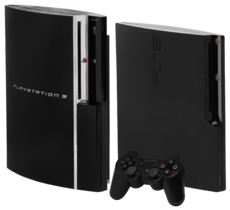 |
